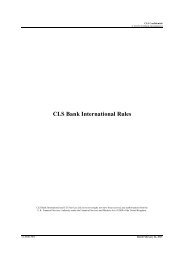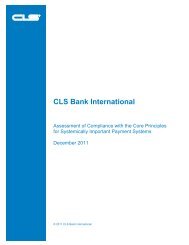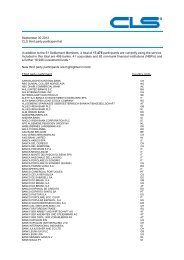CLS Bank Best Practices for Third Party Service Providers and Third ...
CLS Bank Best Practices for Third Party Service Providers and Third ...
CLS Bank Best Practices for Third Party Service Providers and Third ...
You also want an ePaper? Increase the reach of your titles
YUMPU automatically turns print PDFs into web optimized ePapers that Google loves.
<strong>CLS</strong> <strong>Bank</strong> <strong>Best</strong> <strong>Practices</strong> <strong>for</strong> <strong>Third</strong> <strong>Party</strong> <strong>Service</strong> <strong>Providers</strong> <strong>and</strong> <strong>Third</strong> Parties, as ofAugust 2012.As a financial market infrastructure <strong>and</strong> systemically important financial market utility, <strong>CLS</strong> <strong>Bank</strong>International (“<strong>CLS</strong> <strong>Bank</strong>”) seeks to identify, monitor, <strong>and</strong> manage risks that may arise from thesubmission of payment instructions by Members to the <strong>CLS</strong> settlement system, including risksrelating to third party participants to the underlying <strong>for</strong>eign exchange transactions. Accordingly,<strong>CLS</strong> <strong>Bank</strong> Rule 2.1.1 provides that <strong>CLS</strong> <strong>Bank</strong> Members may not have business practices, internalrisk management controls, or any other factor or condition that would create undue risk <strong>for</strong> <strong>CLS</strong><strong>Bank</strong> or its Members.Approved by the Risk Management Committee on August 21, 2012, <strong>Best</strong> <strong>Practices</strong> are designed toidentify <strong>and</strong> mitigate the systemic risks posed by both <strong>Third</strong> <strong>Party</strong> users of <strong>CLS</strong> as well as thoseSettlement Members that provide services to <strong>Third</strong> Parties.1. Conversion of <strong>Third</strong> Parties to Settlement Membership<strong>CLS</strong> will monitor the following settlement <strong>and</strong> funding metrics of <strong>Third</strong> Parties on a regular basisto identify those <strong>Third</strong> Parties whose level of activity is similar to the activity of a <strong>CLS</strong> SettlementMember.a) A <strong>Third</strong> <strong>Party</strong>’s share of total <strong>CLS</strong> daily settlement volume (i.e. number of transactions).b) A <strong>Third</strong> <strong>Party</strong>’s share of total <strong>CLS</strong> daily settlement value (i.e. the gross value oftransactions)c) A <strong>Third</strong> <strong>Party</strong>’s average daily multilateral net pay-in requirement.For these thresholds <strong>CLS</strong> will identify concentration levels that would place the applicable <strong>Third</strong><strong>Party</strong> in the top half of current <strong>CLS</strong> Settlement Members. <strong>CLS</strong> will first contact the <strong>Third</strong> <strong>Party</strong><strong>Service</strong> Provider (TPSP) of a <strong>Third</strong> <strong>Party</strong> exceeding these thresholds <strong>and</strong> discuss with the TPSPan appropriate plan <strong>for</strong> converting the identified <strong>Third</strong> <strong>Party</strong> to full Settlement Membership.<strong>CLS</strong> will also notify the applicable regulatory supervisors of both the TPSP <strong>and</strong> the <strong>Third</strong> <strong>Party</strong>of the conversion opportunity identified.<strong>CLS</strong> recognizes that not all <strong>Third</strong> Parties would be eligible <strong>for</strong> Settlement Membership under thecurrent <strong>CLS</strong> Rules criteria. <strong>CLS</strong> will explore the feasibility of exp<strong>and</strong>ing its SettlementMembership eligibility to other types of non-bank institutions.1
2. <strong>Best</strong> <strong>Practices</strong> <strong>for</strong> <strong>Third</strong> <strong>Party</strong> <strong>Service</strong> <strong>Providers</strong>The following set of best practice recommendations <strong>for</strong> TPSPs are designed to mitigate the risksassociated with the provision of <strong>Third</strong> <strong>Party</strong> services.a) A TPSP should fully underst<strong>and</strong> <strong>and</strong> manage the principal, credit <strong>and</strong> liquidity risks itincurs from its <strong>Third</strong> <strong>Party</strong> clients. In particular a TPSP should closely monitor itsextension of intra-day liquidity overdrafts by currency (to its <strong>Third</strong> Parties) that exceedpre-determined levels set by the TPSP.b) A TPSP should ensure that its <strong>Third</strong> Parties have sufficient funding <strong>and</strong> other financialresources to cover these credit <strong>and</strong> liquidity risks including peak day exposures.c) If a TPSP intends to rescind the <strong>CLS</strong> instructions of a <strong>Third</strong> <strong>Party</strong> customer <strong>for</strong> creditreasons, the TPSP should provide reasonable advance notice to the SettlementMembers of the counter parties of the <strong>Third</strong> <strong>Party</strong>. <strong>CLS</strong> can be used to channel thisnotification.d) Regulators in many jurisdictions are <strong>for</strong>mulating special resolution regimes to provide aframework <strong>for</strong> dealing with troubled institutions. A TPSP should underst<strong>and</strong> the nature ofthese regimes in the jurisdictions of its <strong>Third</strong> <strong>Party</strong> customers. TPSPs are encouraged tocontinue to provide <strong>CLS</strong> settlement services to a <strong>Third</strong> <strong>Party</strong> customer that is subject to aspecial resolution regime.3. <strong>Best</strong> <strong>Practices</strong> <strong>for</strong> <strong>Third</strong> PartiesThe following set of best practice recommendations <strong>for</strong> <strong>Third</strong> Parties are designed to mitigatethe risks associated with the provision of <strong>Third</strong> <strong>Party</strong> services.a) A <strong>Third</strong> <strong>Party</strong> should fully underst<strong>and</strong> <strong>and</strong> manage the principal, credit <strong>and</strong> liquidity risksit incurs from its TPSP. In particular the <strong>Third</strong> <strong>Party</strong> should per<strong>for</strong>m the appropriate duediligence to ascertain that its own <strong>CLS</strong> settlement activity can be accommodated by theTPSP.b) A <strong>Third</strong> <strong>Party</strong> should have contingency plans in place in the event that its TPSP is nolonger able to provide the <strong>Third</strong> <strong>Party</strong> with <strong>CLS</strong> settlement services. A large <strong>Third</strong> <strong>Party</strong>may wish to consider the desirability of splitting its <strong>CLS</strong> settlement activity among severalTPSPs. A large <strong>Third</strong> <strong>Party</strong> should also periodically assess the costs <strong>and</strong> benefits ofbecoming a <strong>CLS</strong> Settlement Member.c) A <strong>Third</strong> <strong>Party</strong> should fully underst<strong>and</strong> the scope of the benefits that it receives from <strong>CLS</strong>settlement. In particular the <strong>Third</strong> <strong>Party</strong> should underst<strong>and</strong> how the <strong>CLS</strong> Rules regardingsettlement finality apply to its own transactions.<strong>Best</strong> <strong>Practices</strong> are subject to change as approved by the Risk Management Committee.Explanatory notes will be added to each <strong>Best</strong> Practice <strong>for</strong> further clarification <strong>and</strong> to reflect anyamendments to the <strong>CLS</strong> <strong>Bank</strong> International Rules or Member H<strong>and</strong>book.Please contact asuljic@cls-bank.com <strong>for</strong> additional in<strong>for</strong>mation.2





